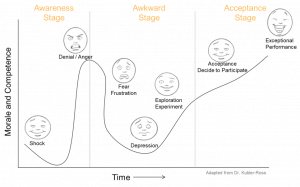Preparing the Team for the Digital Twin Implementation Journey

In my last article, I introduced several technical components you might include in your digital twin efforts. These include equipment condition monitoring, process monitoring, digital worker, networking/connectivity, analytics, data management, and asset + process management, and visibility dashboards. Within each of these, there are several software applications available on the market. I also shared that it takes a team to implement the digital twin, including operations, maintenance, reliability, information technology, leadership, and perhaps most importantly an integration team to stitch the digital twin components together.
With all this in place, it sounds like we are ready to begin our journey. Well, what if some of our target end users are resistant to change? You might hear “I have always done it this way, it works, why change?” “It is too much effort and expense”. “I do not see the value.” How do we get our target end users excited about the changes a digital twin application will bring? This is where change management steps in.
Get started on your digital twin journey today by scheduling a meeting with our innovation team.
Move the people from the current state, through a transitional state, and into a desired future state
Your organization is a collection of people, pursuing a common interest. People, however, have minds of their own. People have their own experiences, fears, and desires. We need to align these with the future state, so the people willingly participate.

Organizational Change Management (OCM) describes an approach to managing changes in a way that minimizes disruption to operations and productivity while maximizing the positive results of change. OCM in its simplest terms includes:
- Getting people to understand the change
- Getting people to desire the change
- Getting people to participate in actions required for the change
To be clear, leadership plays a key role in change management, setting the vision, and supporting the effort to undertake the change journey. In this article, we focus on OCM for technology implementation. People have emotions that cannot be ignored.
People and Emotions
Below is a graphic that shows the ebb and flow of people’s emotions along the digitalization change journey. Along with our technology implementation, we need to address these expected emotions to ensure we get to the future state of our technical implementation without delay.
We need to coach the participants and the rest of the organizational personnel through the 7 phases of emotions. On the X-axis of the graph are morale and competence. One might think of this as the productivity scale. The 7 phases of the emotional journey are:
- Shock: It is a surprise. How does it impact my job, and my friends/colleagues?
- Denial: Pretend the change does not exist. (Productivity returns to “normal”)
- Frustration: People are asked to participate in the new technology changes.
- Depression: The change is inevitable, I must deal with it, and I do not see the value.
- Experiment: I’ll experiment, maybe it is not all that bad.
- Decision: I can live with the new technology; I see some benefits.
- Integration: It is now normal, to use the technology, with improved productivity.

Emotional Stages Graph
For example, a maintenance technician, quality inspector, or assembly operator who performs repetitive tasks will likely be threatened by our technology changes. Senior management is responsible for demonstrating how the new technology simplifies the daily routine AND empowers the individual to achieve higher levels of performance.
To begin, we need to understand three core elements.
- Who will the technology changes affect the most?
- What are the impacts of the change (for the individual)?
- How might the individual feel about and receive the change?
Key tasks for the Change Management Leader
Change management must be driven by transparency, inclusiveness, and reskilling. Senior management must deliver transparent communications and discuss the consequential impact of the changes.
Change management must include and involve employees at the grassroots level, those affected by the change. Identification of the supporters who will “own” their part of the change and will serve as champions to socialize the benefits of the technology change. The change management leader, in concert with the identified supporters, must help other employees see the benefits of the technology change and feel comfortable with the change. Change cannot be forced.
There likely is some reskilling to do. This allows those employees to grow in their careers and their roles within the company.
Change management must include sharing a vision, the plan to get there, the resources and activities along the way, the inclusion necessary so people choose to participate, and a way to measure progress and success.
Summary
To start the change management process, it is a must to engage leadership immediately. The digital twin implementation can be a significant change for the organization. The digital twin implementation needs visible, consistent, and committed leadership support. To help with leadership support, consider conducting a strategic alignment meeting and discussing the project vision statement.
Be careful to understand the impacts of change. How does the work change for impacted employees? Consider a transition team to help employees participate and develop a sense of ownership for the new system(s). Training will play a significant role, such that employees have an opportunity to learn the new and provide feedback. Create incentives for the employees to participate.
Measure progress and success. Such progress and success measures should be part of the ongoing communication. Measurement shows concrete movement towards the future state and provides the opportunity to re-iterate the benefits of arriving at the future state.
References:
1: “Organizational Change Management for Dummies”, 2015, John Wiley and Sons, Inc.
2: “A Low-Risk, Incremental Approach to Smart Manufacturing for Small & Medium Manufactures”, MESA International, Smart Manufacturing Working Group.
